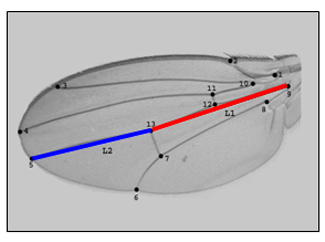Evolution could be predictable

Geographic clines in body size are widespread in Drosophila. Larger individuals are encountered at higher latitudes, and the differences have a genetic basis. But the reason for this still remains a mystery. The invasion of the Americas by the native Palearctic species Drosophila subobscura about 30 years ago provided a unique opportunity to determine if a body size cline would eventually emerge; that is, if evolution is predictable.
Researches found that a wing size cline indeed evolved after 20 years since the initial colonization, and that it was convergent with the ancestral Old World cline. However, the underlying details were different between the new and the old clines! In Europe the size cline was a consequence of a latitudinal lengthening of the basal wing section, whereas in America it is the distal wing section that increases with latitude. This lead to the conclusion that the evolution of geographic variation in wing length is predictable, but the means by which it occurs is contingent. We challenge this assertion and conclude that these contrasting patterns came out as a correlated response of inversion clines that might have been predicted considering the genetic background of colonizers.
Does history follow any patterns? The English historian Herbert Fisher in his book History of Europe wrote: “Men wiser and more learned than I have discerned in history a plot, a predetermined pattern. These harmonies are concealed from me. I can see only one emergency following upon another and only one safe rule for the historian: that he should recognize in the development of human destinies the play of the contingent and the unforeseen.” Evolution is a historical science and the tension between contingency (a term used to describe a phenomenon subject to chance, but its precise meaning is different: contingent means something that is not strictly necessary, which may or may not be) and predictability has fuelled hotly contested debates among evolutionary biologists. This is forcefully emphasized by the following quotations:
“…if the tape of evolution were replayed a million times, a species like ours would not necessarily evolve.”
Stephen Jay Gould, Wonderful life (1989)
“Evolution shows an eerie predictability, leading to the direct contradiction of the widely-held view that insists on evolution being governed by the contingencies.”
Simon Conway Morris, Life’s solution (2003)
The invasion of the Americas by D. subobscura started when a handful of flies (less than 15), most likely from south-western Europe, crossed to Chile in the late 1970s. The genetic bottleneck resulting from this small sample did not prevent the rapid evolution of latitudinal clines for chromosomal structures (inversions) that were convergent with the long standing clines in native European populations. However, we have shown that the bottleneck did change the genetic associations between inversions and those genes related to the lengths of the different sections of the wing (basal and distal) that are involved in the wing size clines. This leads to the following prediction. Since the inversions that increase in frequency at higher latitudes are the same in Europe and America, and since their relation with the length of the two wing sections is just opposite, then the underlying details of the wing size clines should also be opposite. Eureka! That was exactly what we found. Therefore, although historical effects that originated from the bottleneck were important, the contrasting patterns in the details of the wing clines were largely predictable. Take any quotation you want, both are partially true.
Figure.- Discrepant clines in wing shape have resulted from changes in genetic structure during colonization of the Americas.
References
"Contrasting patterns of phenotypic variation linked to chromosomal inversions in native and colonizing populations of Drosophila subobscura". Fragata, I.; Balanya, J.; Rego, C.; Matos, M.; Rezende, E. L.; Santos, M. JOURNAL OF EVOLUTIONARY BIOLOGY, 23 (1): 112-123 JAN 2010.


